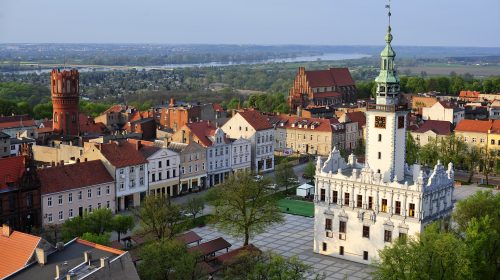Wąbrzeźno is a town located in the Chełmińskie Lake District, at the very centre of the historic Chełmno land, among three lakes, namely Lake Zamkowe, Lake Sicieńskie and Lake Frydek.
In the Early Middle Ages, a small settlement was established in this area, the main element of which was a fortified town, probably established in the 9th Century on the peninsula that separates Lake Zamkowe and Lake Frydek. The town was destroyed in the wake of a raid of the Prussian tribes.
From 1246 onwards, the area was owned by the bishops of Chełmno. The year 1246 also marks the first documented mention of the existence of the settlement in Wąbrzeźno, under the name Wambrez. At the beginning of the 14th Century, the then bishop of Chełmno initiated the building of a castle, which was later destroyed.
Another significant event in the history of the town was granting a foundation charter by Bishop Johannes Dantiscus, which happened in 1534. At the time, Wąbrzeźno was granted its own seal and coat of arms, the latter of which depicts a black wing of an eagle pierced in the bottom by a golden crosier, on a red background.
Although not all of its historic buildings have been preserved to this day, resulting from the turbulent history of the town, there are still many left to admire and prove that the town was once a wealthy place. Among them are the ruins of the castle where the bishops of Chełmno used to reside, the Apostles Saint Simon and Jude Thaddeus Parish Church, erected in the years 1323-1349, a former evangelical church later converted to the Mother of God Queen of Poland’s Roman Catholic Church, the neo-Gothic building of a district court with a prison located in the basement, erected in 1880, and also the two beautiful tenement houses with annexes, one located at ul. 1 Maja (a Neo-Renaissance house) and the other at Plac Jana Pawła II 22, which today functions as the presbytery of the Parish of the Mother of God Queen of Poland. Among other eye-catching buildings, there is the Police Headquarters building dating back to the 19th Century, the neo-Gothic Town Hallfrom 1892 built using red unclad brickwork and decorated with decorative bricks with little turrets, the neo-Gothic post office building erected in 1892, using red decorative brickwork, with bars from the period and little turrets at the front, converted at the beginning of the 20th Century, or Dom Klimków (The Klimek Family House) located at ul. 1 Maja, in Art Noveau style, dating back to the beginning of the 20th Century.
Do you want to visit this place?
Use Google navigation

